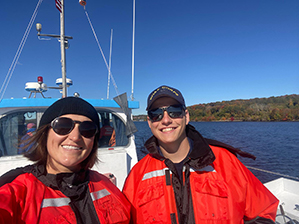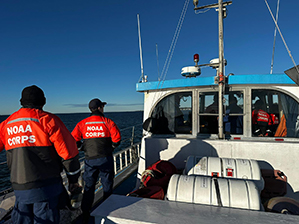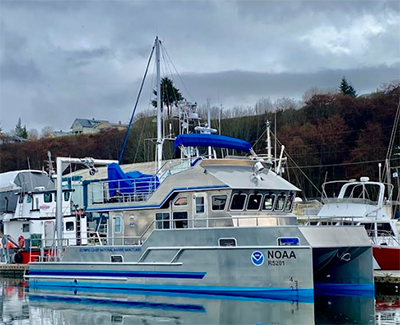Greetings, NOAA Corps colleagues,
As you may have seen earlier this week, the FY2024 Officer Corps Management Plan (OCMP) has been approved by RADM Hann. Notably, OCMD has received numerous calls from officers wanting to know more about this document and how it may impact them. Therefore, I’ve asked our illustrious Workforce Planner, Michael McCarthy, to take the pen this week and share some insight on the OCMP. I hope you enjoy it!
Best Regards,

Captain Chris van Westendorp, NOAA
Director, Commissioned Personnel Center
One popular question coming up is, “How are Officer Corps Management Plan (OCMP) zone sizes estimated?” Factors that impact zone size calculations for promotion have some unknowns such as appropriations (how many officers can we afford), attrition, officers approved for promotion, interservice transfers, direct appointments, and grade percentage distribution.
With the intent to grow the NOAA Corps, officer promotions are a means to meet experience expectations, workload demands, and right sizing of officers by grade. We can adjust the grade percentage distribution annually to control the growth within grades to meet mission demands. And, with promotions having a top-down flow, each higher-grade promotion can generate a promotion for each lower grade. If one commander is promoted captain, a lieutenant commander may get promoted to meet the commander loss, and so on.
NOAA Corps officer needs are based upon the average annual strength (AAS) and grade percentage distribution. We can estimate potential losses through average attrition by grade and multiplying that number to cover a one-and-a-half-year period, with the intent for officers to pin on their new rank to fill grade gaps from attrition or promotion on-time. Example: A captain grade percentage distribution of 8% with AAS of 337 comes out to about 27 captains. If we have an average attrition of 5 captains per year, a year and a half estimate would result in potential future gaps of; (5 x 1.5 = 7.5) rounded up to 8. If we already have 2 commanders approved for promotion to captain we would subtract the 2 leaving a need for 6 potential promotions.
Taking the captain calculation plus the trickle-down effect, 6 commanders are added to the average commander attrition rate over a year and a half. With commander annual attrition rate of 7 we would use the product (7 x 1.5 = 10.5) rounded up to 11, and add in the 6 potential commander promotions to captain losses for an estimated selection of 17. Lastly, we would then subtract the number of lieutenant commanders already approved for promotion, say 4, to give us an estimated number to promotion selections of 13. This continues through the remainder of the grades with the added contribution of reserving space for pending interservice transfer (IST) and direct appointment (DA) officers to join the NOAA Corps.
With an estimated number of officers to select we'll review the lineal list to determine the zone sizes, including factors of time in grade, time in service specifically for an IST and DA (must have one year with NOAA Corps for promotion consideration), and cohorts. While seemingly subjective, considerations must be given to help prevent unnecessarily large zone sizes and officers potentially being passed over early for promotion.
As you can see, there are changing factors impacting promotion zones each year. The NOAA Corps Director helps set the parameters of the OCMP, and you’ll see that the FY2024 OCMP discussion section addresses some of the factors impacting zone sizes. At the moment, the FY2025 OCMP is not expected to be as robust, but as always, we shall see. For those officers who are curious about when they might be in a promotion zone, I encourage them to take a look at the lineal list, paying attention to prior and current OCMPs, as well as the factors mentioned above, and they may get a sense of where and when they may be up for promotion consideration.
Be Well,
Michael McCarthy
| 17 Nov 2023 | BOTC-142 Graduation, Radar training, Advanced Firefighting Training |
| 11 Dec 2023 | Officer Assignment Board |
| 16 Jan 2024 | Ops Working Group |
| LT Hollis Europe | 01 Nov 2023 |
| LCDR Richard DeTriquet | 30 Nov 2023 |
| LCDR Alan Hough | 30 Nov 2023 |
| LCDR Bryan Begun | 01 Dec 2023 |
| LT Lee Shoemaker | 01 Dec 2023 |
| LT Frank Centinello | 08 Dec 2023 |
| LTJG Samuel Umfress | 15 Dec 2023 |
| CDR Lindsay Kurelja | 01 Jan 2024 |
| LTJG Tyler Aldrich | 31 Jan 2024 |
| LTJG Gabriella McGann | 15 Feb 2024 |
| LTJG Katherine Mitchell | 20 Feb 2024 |
| ENS Norman Sween | 29 Feb 2024 |

142 aboard Project O. Photo Credit: OC Sixt |
BOTC 142 has been full steam ahead with academics and developing leadership skills. The big test, “Rules of the Road”, finally arrived. Rules of the Road, or the navigation rules, are regulations that guide mariners in safe navigation and preventing collisions at sea, essential knowledge for being future Officers on NOAA vessels. BOTC 142 did very well overall, winning the academic pennant for the highest average grade in the company.

142 aboard Project O. Photo Credit: OC Sixt |
The following week, BOTC 142 began Leadership and Management (LAMs) class. This class covered conflict management, identifying personal behavioral styles, and motivational factors to name a few. The class was very enjoyable and engaging, furthering BOTC 142’s understanding on what makes a great leader. Also during LAMs week, the entirety of OCS/BOTC was graciously invited to Admiral Johnston’s house for a New Orleans themed dinner and social event. Admiral Johnston is the 43rd superintendent of the US Coast Guard Academy. Thank you, Admiral Johnston!
This week BOTC 142 was split into two academic groups with one going to RADAR training at USMRC in Newport, RI, and the other getting more ship handling experience on Project Oceanology’s research vessel back in Groton, CT.
The announcement in the last Cyberflash for the BOTC 142 Mentorship Program had a typo in the application deadline. All interested should complete the linked form by November 9, 2023 (vice December 9).
NOAA Corps Recruiting is looking for motivated Officers (O2-O4) who are willing to complete interviews for BOTC 144. To improve consistency, Recruiting is asking each interviewer to conduct a minimum of 3-5 interviews.
Officers will conduct all interviews virtually via Google Meet. Interviews can be scheduled as early as the second week of November, with all interviews completed by January 6th.
This interview process is your chance to have a direct hand in shaping the future of the NOAA Corps. Please email LT Ryan A Musick at apply.noaacorps@noaa.gov if you are interested. Thank you for your consideration!

|
Olympic Coast National Marine Sanctuary (OCNMS) is seeking a motivated junior officer to join their team as the Vessel Operations Coordinator (VOC) in Port Angeles, Washington. OCNMS consists of an area approximately 3,188 square miles along the coast of Washington. The sanctuary shoreline measures approximately 135 miles from Cape Flattery to the Copalis River, bordering Olympic National Park and the reservations of four coast treaty tribes. This billet provides an excellent opportunity to stay operational aboard the 52’ R/V Storm Petrel from May to October, develop key leadership skills as the administrative officer for OCNMS staff and facilities, and serve as the liaison between the USCG and coastal treaty tribes of Washington for all research and vessel operations.
Interested officers rotating between January 2025 and June 2025 should contact LTJG Haley Wilson at haley.wilson@noaa.gov; or the assignment coordinator to learn more.